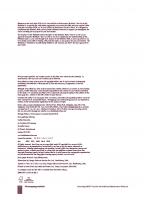Cambridge IGCSE™ and O Level Environmental Management Workbook (Cambridge International IGCSE) [Workbook ed.] 9781316634875
Resources tailored to the Cambridge IGCSE® (0680) and O Level (5014) Environmental Management syllabuses, for first exam
1,652 186 11MB
English Pages 166 [159] Year 2017
Recommend Papers
![Cambridge IGCSE™ and O Level Environmental Management Workbook (Cambridge International IGCSE) [Workbook ed.]
9781316634875](https://ebin.pub/img/200x200/cambridge-igcse-and-o-level-environmental-management-workbook-cambridge-international-igcse-workbooknbsped-9781316634875.jpg)
- Author / Uploaded
- Gary Skinner
- Ken Crafer
- Melissa Turner
- Ann Skinner
File loading please wait...
Citation preview
Gary Skinner, Ken Crafer, Melissa Turner and Ann Skinner
Cambridge IGCSE® and O Level
Environmental Management Workbook
Contents Skills grid Introduction 0 Key skills in Environmental Management KS.1 Aims and hypotheses testing, experimental design KS.2 Collecting data KS.3 Recording data KS.4 Presenting data KS.5 Analysing data KS.6 Drawing conclusions and evaluating 1 Rocks and minerals and their exploitation 1.1 The rock cycle 1.2 Extracting rocks and minerals 1.3 The impacts of rock and mineral extraction 1.4 Managing the impact of rock and mineral extraction 1.5 The sustainable use of rocks and minerals 2 Energy and the environment 2.1 Fossil fuels 2.2 Energy resources 2.3 The demand for energy 2.4 Conservation and management of energy resources 2.5 Impact of oil pollution 2.6 Management of oil pollution 3 Agriculture and the environment 3.1 The composition of soil 3.2 Components needed in soil for plant growth 3.3 Understanding the availability and effect of soil nutrients 3.4 Comparing the use and properties of clay and sandy soils 3.5 Classifying types of agriculture 3.6 Improving agricultural yield 3.7 Controlling the growing environment 3.8 Impacts on the environment 3.9 Managing soil erosion 3.10 Sustainable farming 4 Water and its management 4.1 The distribution of water on Earth 4.2 The water cycle 4.3 Why humans need water 4.4 The main sources of fresh water for human use 4.5 Availability of safe drinking water around the world 4.6 Multipurpose dam projects 4.7 Water-related diseases 4.8 Disposing of human waste safely and delivering potable water to people 4.9 Pollution of water by industry 4.10 Acid rain 4.11 Eutrophication 5 Oceans and fisheries 5.1 The resource potential of the oceans 5.2 World fisheries 5.3 Exploitation of the oceans: impact on fisheries 5.4 Strategies for managing the harvesting of marine species 6 Managing natural hazards 6.1 Definitions 6.2 Comparing natural hazards, focusing on volcanoes 6.3 Flooding and management strategies 6.4 The impacts of drought
6.5 The impacts of tropical cyclones 6.6 Review of natural hazards 7 The atmosphere and human activities 7.1 The structure and composition of the atmosphere 7.2 Global climate change 7.3 Ozone depletion 7.4 The causes, impacts and management of smog 7.5 The causes, impacts and management of acid rain 7.6 A review of atmospheric pollution 8 Human population 8.1 Changes in population size 8.2 Human population distribution and density 8.3 Population structure 8.4 Managing human populations 9 Natural ecosystems and human activity 9.1 The ecosystem 9.2 Estimating biodiversity in ecosystems 9.3 The causes and impacts of habitat loss 9.4 The causes and impacts of deforestation 9.5 The need for the sustainable management of nature 9.6 Strategies for conserving the biodiversity and genetic resources of natural ecosystems
Skills grid ®
This grid maps the workbook exercises to the Cambridge IGCSE and O Level Environmental Management assessment objectives. Workbook chapters Assessment objectives
Key skills in Environmental Management
1
2
3
4
5
6
7
8
9
3.1, 3.2, 3.3, 3.4, 3.5, 3.6, 3.9, 3.10 3.1, 3.2, 3.5, 3.9, 3.10 3.7, 3.8
4.2, 4.4, 4.5, 4.7, 4.8
5.1, 5.2, 5.3, 5.4
6.1, 6.3, 6.5
7.1, 7.2, 7.3, 7.4, 7.5
8.1, 8.2, 8.3, 8.4
9.1, 9.2, 9.3, 9.5, 9.6
4.2, 4.4, 4.5, 4.7, 4.8 4.8
5.1, 5.2, 5.4
6.1, 6.3, 6.5
7.1, 7.2, 7.5
8.1, 8.3
9.1, 9.2, 9.5
6.3
7.1, 7.3
9.6
AO1 Knowledge with understanding 1 Phenomena, facts, definitions, concepts and theories
1.1, 1.2, 1.5
2.1, 2.2, 2.3, 2.5
2 Vocabulary, terminology and conventions
1.1, 1.5
2.1, 2.2
3 Technological applications with their social, economic and environmental implications.
1.2, 1.3, 1.4
2.2, 2.4, 2.5, 2.6
AO2 Information handling and analysis 1 Locate, select, organise and present information from a variety of sources 2 Translate information and evidence from one form to another
KS.4
1.4
2.2, 2.6
3.1, 3.6
4.8
6.2
7.2, 7.3, 7.4
8.1, 8.3
9.1, 9.3, 9.6
KS.3, KS.4
1.4
2.2, 2.3, 2.6
4.3, 4.8
5.1, 5.2
6.2, 6.4
7.2
8.1
9.1, 9.3
3 Manipulate numerical data
KS.5
1.4
2.3, 2.4, 2.6
3.3, 3.4, 3.6, 3.7 3.4, 3.6
4.1, 4.8
5.1, 5.3
6.2, 6.3, 6.4
7.2, 7.3, 7.4
8.1, 8.2, 8.3
4 Interpret and evaluate data, report trends and draw inferences.
KS.5
2.3, 2.4, 2.6
3.6, 3.9
4.8
5.2
6.2, 6.4
7.2, 7.4
8.1
9.1, 9.3, 9.4, 9.5, 9.6 9.1, 9.5
1.4
2.4
3.4 3.4
4.11
5.4 5.4
6.5 6.5
7.4 7.4
8.1
9.2
2.1, 2.4
3.4, 3.9, 3.10
4.6, 4.7
5.3
6.2, 6.3, 6.4
7.2
8.1
9.1, 9.4, 9.6
1.3, 1.4
2.4, 2.6
3.1, 3.4, 3.5, 3.9, 3.10
4.2, 4.3, 4.4, 4.6, 4.7, 4.8
5.1, 5.2, 5.4
6.2, 6.3, 6.4
7.2
8.1, 8.4
9.3, 9.4, 9.5, 9.6
AO3 Investigation skills and making judgements 1 Plan investigations 2 Identify limitations of methods and suggest possible improvements 3 Present reasoned explanations for phenomena, patterns and relationships
KS.1, KS.2 KS.2, KS.6
4 Make reasoned judgements and reach conclusions based on qualitative and quantitative information.
KS.6
Introduction This book has been written to help you increase your understanding of the topics covered in your Cambridge IGCSE® or O Level Environmental Management course. The exercises in this workbook will give you opportunities to: develop your knowledge and understanding of different aspects of the course, including different phenomena, definitions and vocabulary practise handling information and solving problems develop your investigation and evaluation skills practise drawing and interpreting diagrams, including graphs. Most of the exercises are somewhat different from examination questions. This is because they are designed to help you develop your knowledge, skills and understanding. The Skills grid at the beginning of the book shows how each exercise maps to the course’s assessment objectives. The first chapter focuses on developing your investigation and data handling skills. The rest of the chapters put more emphasis on your knowledge and understanding of the course content. Each exercise starts with an introduction explaining the skills that it will help you to practise. Spaces have been left for you to write your answers. Some of the diagrams are incomplete, and your task will be to complete them.
Chapter 0: Key skills in Environmental Management In all IGCSE subjects, certain skills are examined in addition to the knowledge of the content of the syllabus. Science subjects, such as Environmental Management, involve a subset of skills which are dealt with in this chapter. These skills fall into two main categories: information handling and analysis investigation skills. The following workbook questions focus on these two groups of skills. In addition, the coursebook questions will very often involve the use of these skills in the context of syllabus topics.
Exercise KS.1 Aims and hypotheses testing, experimental design The aim of the investigation identifies why it is being done. Once the aim has been decided, a hypothesis can be written. To test the hypothesis, scientists will most commonly design an experiment. An experiment is a situation in which one variable (x, the independent variable) is changed and its effect on another variable (y, the dependent variable) is measured. This exercise will help you to improve your understanding of experimental design. It will give you practice in formulating hypotheses. 1 a An investigation has the aim 'to investigate the effects of soil pH on the growth of plants near a mine waste tip'. Suggest a suitable null hypothesis for this investigation.
b Explain how you could collect data to decide whether the null hypothesis you have written can be accepted or rejected. That is, how would you test your hypothesis?
c An experiment was carried out and the following results were obtained.
Describe the relationship between pH and plant height, and explain whether you think that the null hypothesis you have suggested in part a will be rejected or accepted in the light of these results.
2 An agricultural scientist was asked to find out if some heavy-metal pollution, which was getting into the irrigation water on some crop fields, was affecting crop growth. It was decided to do the experiment on plots outside rather than setting it up in pots in the laboratory. A large field was chosen where no natural heavy-metal pollution was affecting the irrigation water. Four concentrations of the heavy metal were investigated. The field was divided into four plots. A maize crop was grown in each plot. Each plot was irrigated with pure water or water contaminated with the heavy metal. The total mass of maize cobs harvested was measured. a Suggest an experimental hypothesis for this investigation.
b In this experiment, state the name of the independent variable and of the dependent variable. independent variable ............................................................................................ dependent variable .............................................................................................. c Name two control variables in this experiment that are to do with the maize crop.
d Name two control variables in this experiment to do with the physical (abiotic) environment in which the maize is growing.
e Explain how the design of the experiment will ensure, as far as possible, that the variables you have named in part d will be the same in all four plots.
Exercise KS.2 Collecting data Data, in the context of a scientific experiment, will usually be numbers obtained from the experiment. It is important that you know what type of data have been obtained. There are two main types: quantitative and qualitative. Quantitative data can either be discrete or continuous and qualitative data is information that cannot be measured, like peoples’ opinions. People’s opinions can be expressed through some kind of interview, which can be structured in the form of a questionnaire. This exercise will help to improve your ability to select equipment for a stated purpose and design questionnaires. It will allow you to practise recognising different types of data. 1 The heavy-metal pollutant mentioned in Exercise KS. 1 question 2 (pages 2–3), was also found to be contaminating streams, rivers and lakes in the area. A zoologist was asked to look at the effect of this on fish growth and reproduction. The hypotheses which were tested were: ‘the growth rate of fish will be lower in the presence of higher heavy-metal concentrations in the water’ and ‘fish will produce fewer eggs in the presence of heavy metal in the water’. a Explain how you would make the measurements needed to test the first hypothesis.
b The particular species of fish investigated produced very large numbers of quite small eggs. Counting all of the eggs produced by a single female fish would not be possible. Explain how you could get a good estimate of the total number of eggs being laid by female fish without having to count them all.
c i Circle the correct description of the data which will be obtained when testing the hypothesis about fish growth.
qualitative continuous qualitative discrete
quantitative continuous quantitative discrete
ii Circle the correct description of the data which will be obtained when testing the hypothesis about fish reproduction.
qualitative continuous
quantitative continuous
qualitative discrete
quantitative discrete
2 In a follow-up study, people in the area where heavy-metal pollution occurred were asked about their concerns using a questionnaire. Here are some of the questions they were asked:
A How concerned are you about the pollution of your water supply with heavy metals?
very concerned
concerned
don’t know
not concerned
B Please tell me about any incidents in which you think you were affected by using water polluted with heavy metal.
C How much water do you drink in a day?
< 1 L
about 1 L
> 1 L
D Who do you blame for the heavy-metal pollution?
a There are two main types of questions in a questionnaire: closed questions and open questions. Which of questions A to D in the questionnaire do you think are open and which are closed? open questions ..................................................................................................................................................................... closed questions ..................................................................................................................................................................... b After the scientist wrote the questions shown, it was decided that the order in which they were asked could be improved. Suggest a better order for these questions and explain your answer.
c Suggest two further questions that could be asked in this questionnaire. One of the questions should be closed and one should be open.
Exercise KS.3 Recording data It is important to have a clear and sensible way of recording your data before starting an investigation. This exercise will give you some practice at deciding how to record results. 1 a When counting the fish eggs in the investigation described in Exercise KS.2 question 1b (page 4), a tally chart was used. In one square 73 eggs were counted. Write down the tally chart record of this number of eggs.
b In the same investigation, seven concentrations of heavy metal, including zero, were used. The number of eggs laid by five females at each concentration was estimated. A mean number of eggs per female was then calculated. The heavy-metal concentrations were designated 0 to 6. Draw a table in which the results of this experiment could be recorded, together with the calculated mean.
Exercise KS.4 Presenting data There are many ways of presenting the data collected in an investigation. Ideally, it should be recorded in a table. Once the data is neatly presented in a table, it can be displayed. This will usually be in the form of a graph or chart. This exercise will help you to practise your graph plotting skills. It will also help you to choose which type of graph or chart to use for different kinds of data. 1 a In the investigation described to test the two hypotheses in Exercise KS.2 question 1 (pages 4–5), the data obtained were treated in two different ways. In one case the data were growth rates (expressed as gain in mass per day) and in the other the number of eggs. In both cases the scientist was looking at the effect of heavy-metal concentration on these variables. There are generally five ways in which you might choose to present data. These are a line graph, a bar chart, a histogram, a pie chart and a scattergraph. State which of these you would use to present the data that were obtained to test the two hypotheses in Exercise KS.2 question 1 (pages 4–5). Explain why you have chosen this method.
b Another study was done which measured the percentage of various species of fish in which egg laying was reduced by the heavy-metal pollutants. The results are shown in the table. Category of effect of heavy metal on fish egg laying
Percentage of fish species affected in this category
unaffected
7
slightly affected
23
significantly affected
52
very badly affected
18
State which of the data presentation techniques you would use to display these data. Explain your answer. Give an alternative method that would still be suitable.
c The data on which this categorisation was based are shown below. Number of eggs laid as a percentage of the number laid with no heavy-metal pollutant
Number of species laying this percentage of normal number of eggs
100–80
2

![Cambridge IGCSE and O Level Economics (Cambridge Igcse & O Level) [UK ed.]
1444196413, 9781444196412](https://ebin.pub/img/200x200/cambridge-igcse-and-o-level-economics-cambridge-igcse-amp-o-level-uk-ed-1444196413-9781444196412.jpg)



![Cambridge IGCSE® Environmental Management: Student Book (Collins Cambridge IGCSE ®) [2017 ed.]
0008190453, 9780008190453](https://ebin.pub/img/200x200/cambridge-igcse-environmental-management-student-book-collins-cambridge-igcse-2017nbsped-0008190453-9780008190453.jpg)
![Cambridge IGCSE® and O Level: Economics [2 ed.]
9781510420205](https://ebin.pub/img/200x200/cambridge-igcse-and-o-level-economics-2nbsped-9781510420205.jpg)


![Cambridge IGCSE and O Level Computer Science Computer Systems Workbook [Workbook ed.]
1398318493, 9781398318496](https://ebin.pub/img/200x200/cambridge-igcse-and-o-level-computer-science-computer-systems-workbook-workbooknbsped-1398318493-9781398318496.jpg)